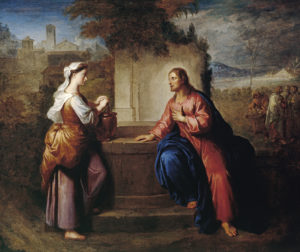Object of the Month: September 2015
Christ and the Samaritan Woman
Oil on canvas
François de Troy
French, 1645–1730
Click on the links throughout the article to view additional artists’ works and reference material.
Born in 1645 in Toulouse, France, François de Troy eagerly embraced the artistic tradition established by his father, Nicolas de Troy. François and his brother Jean trained together in their father’s Toulouse workshop. (Interestingly, François is often confused with his son, Jean-François de Troy, who he trained to continue the family’s artistic legacy). Sometime after age 17, Francois re-located to Paris where he refined and improved his talents under the tutelage of artists such as Claude Lefèbvre and Nicolas-Pierre Loir. It was here in Paris that he officially began his career as a portraitist.
In 1671, Francois applied to the Académie Royale de Peinture et Sculpture. However, it wasn’t until three years later, at age 29, that the Académie accepted him. This sparked a longtime affiliation with the Académie as he served in many roles: elected as an adjunct professor in 1692, a full-time professor one year later, the coveted position of Director from 1708–1711, and adjunct rector in 1722.
The key to his success as a portraitist came in 1679 when he was selected by King Louis XIV, the Sun King, to paint an engagement portrait of Duchess Maria Anna Victoria of Bavaria (who was to marry his son and heir, Louis, the Grand Dauphin). This critical commission launched his career as he became one of the leading portrait artists during the reign of Louis XIV and the most sought after French portraitist of his time. From that point forward, he would continue to work for Louis XIV, Madame de Montespan (one of the King’s many mistresses), and their descendants (including Louis XV). His fame even brought him many commissions from the exiled King James II of England, his family, and loyal followers who were residing in Saint-Germain-en-Laye.
De Troy’s style evidences the influence of Flemish portraiture and artists such as Rubens and van Dyck. Many of his portraits showcase the warm coloring and dynamic compositions often seen in the Golden Age of Dutch portrait painting. Exhibited at the Salon of 1704, the Museum & Gallery’s Christ and the Samaritan Woman, while not a portrait, beautifully highlights the skill and qualities that epitomize de Troy’s style and career. Compare M&G’s work with de Troy’s Astronomy Lesson of the Duchesse du Maine completed sometime in 1702–1704. Both exhibit the rich, warm colors of de Troy’s style as well as a central placement of the primary figures.
John 4 records the tender encounter at the well between Christ and this Samaritan woman. Christ and his disciples had to pass through the region of Samaria on their way back to Galilee. This would have been particularly distasteful to any traveling Jew because of the longstanding hatred between the Jews and Samaritans.
While the disciples go into the city to purchase food, Christ chooses to rest at the well, where a Samaritan woman comes to draw water. Christ does the unthinkable and engages the Samaritan woman in conversation asking her, “Will you give me a drink?” Because the Jews and Samaritans would not associate with one another, the woman understandably states, “You are a Jew and I am a Samaritan woman. How can you ask me for a drink?” As He gently leans in to close the physical gap between them, de Troy’s Christ removes the barriers built by their conflicting cultures and offers her the “living water” that only He can provide. His knowledge of her past and present sins combined with his kindness and loving offer, motivates her to seek this “living water” and share it with the people in her town who curiously come to see this prophet. Remarkably, Christ remains in Samaria for two days at the invitation of the townspeople, and many come to believe in Him as they tell the woman, “We no longer believe just because of what you said; now we have heard for ourselves, and we know that this man really is the Savior of the world.”
Rebekah Cobb, Guest Relations Manager & Docent
Published in 2015
